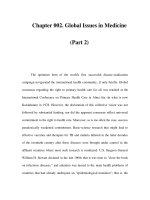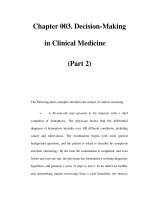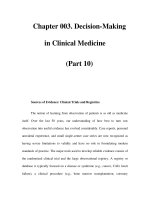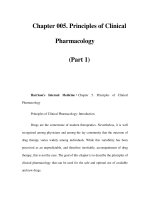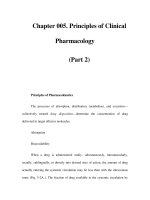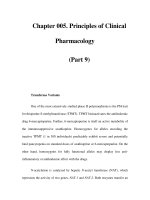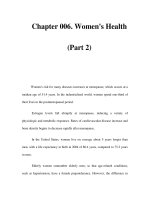CLINICAL SKILLS - PART 2 pps
Bạn đang xem bản rút gọn của tài liệu. Xem và tải ngay bản đầy đủ của tài liệu tại đây (222.81 KB, 33 trang )
CHAPTER 2
General Examination
The initial assessment of the patient will have been made whilst taking a
history.The general appearance of the patient is the first observa-
tion, and thereafter the order of examination will vary.
The system to which the presenting symptoms refer is often examined
first. Otherwise devise your own routine, examining each part of the
body in turn, covering all systems.An example is:
– general appearance
– alertness, mood, general behaviour
– hands and nails
– radial pulse
– axillary nodes
– cervical lymph nodes
– facies, eyes, tongue
– jugular venous pressure
– heart, breasts
– respiratory system
– spine (whilst patient is sitting forward)
– abdomen, including femoral pulses
– legs
– nervous system including fundi
– rectal or pelvic examination
– gait
Whichever part of the body one is examining, one should always use
the same routine:
1 Inspection.
2Palpation.
26
3Percussion.
4 Auscultation.
General inspection
The beginning of the examination is a careful observation of the
patient as a whole. Note the following:
°
Does the patient look ill?
– what age does he look?
– febrile, dehydrated
– alert, confused, drowsy
– cooperative, happy, sad, resentful
– fat, muscular, wasted
– in pain or distressed
Hands
Note the following:
°
Temperature:
– unduly cold hands
—
? low cardiac output
– unduly warm hands
—
? high-output state,e.g. thyrotoxicosis
– cold and sweaty
—
? anxiety or other causes of sympathetic overreac-
tivity,e.g. hypoglycaemia
°
Peripheral cyanosis.
°
Raynaud’s.
°
Nicotine staining.
°
Nails:
– bitten
– leukonychia
—
white nails
—
can occur in cirrhosis
– koilonychia
—
misshapen, concave nails (Plate 2d)
—
can occur in iron-deficiency anaemia
– clubbing
—
loss of angle at base of nail (Plate 2a)
Hands 27
Normal
Koilonychia
Nail clubbing occurs in specific diseases:
Heart: infectious endocarditis, cyanotic congenital heart disease.
Lungs: carcinoma of the bronchus (chronic infection: abscess;
bronchiectasis,e.g. cystic fibrosis; empyema); fibrosing alveolitis
(not chronic bronchitis).
Liver: cirrhosis.
Crohn’s disease.
Congenital.
– splinter haemorrhages
—
occur in infectious endo-
carditis but are more common in people doing
manual work
– pitting
—
psoriasis
– onycholysis
—
separation of nail from nail bed
psoriasis, thyrotoxicosis
– paronychia
—
pustule in lateral nail fold
°
Palms:
– erythema
—
can be normal, also occurs with
chronic liver disease, pregnancy
– Dupuytren’s contracture (Plate 4c)
—
tether-
ing of skin in palm to flexor tendon of fourth
finger
°
Joints:
– symmetrical swellings occur in rheumatoid arthritis (Plate 2e)
– asymmetrical swellings occur in gout (Plate 2f) and osteoarthritis
28 Chapter 2:General Examination
(a) Fingers held together
—
space seen at X as a result of normal angles in the
fingers. (b) Positive Schamroth’s sign
—
space is lost as a result of clubbing.
X
Normal Club finger(a) (b)
Clubbing
Splinter
haemorrhages
Skin
Inspection of skin
–
distribution of any lesions from end of bed
– examine close up with palpation of skin
– remember mucous membranes, hair and nails
°
Colour:
– pigmented apart from racial pigmentation or suntan
—
examine
buccal mucosa
– if appears jaundiced
—
examine sclerae
– if pale
—
examine conjunctivae for anaemia
°
Skin texture:
– ? normal for age
—
becomes thinner from age 50
– thin, e.g. Cushing’s syndrome, hypothyroid, hypopituitary, malnutrition,
liver or renal failure
– thick, e.g. acromegaly, androgen excess
– dry, e.g. hypothyroid
– tethered, e.g. scleroderma of fingers, attached to underlying breast
tumour
°
Rash:
– what is it like? Describe precisely
Inspection of lesions
–
distribution of lesions:
symmetrical or asymmetrical
peripheral or mainly on trunk
maximal on light-exposed sites
pattern of contact with known agents, e.g. shoes, gloves,
cosmetics
– number and size of lesions
– look at an early lesion
– discrete or confluent
– pattern of lesions, e.g. linear, annular, serpiginous (like a snake),
reticular (like a net)
– is edge well-demarcated?
Skin 29
– colour
– surface, e.g. scaly, shiny
Palpation of lesions
–
flat, impalpable
—
macular (Plate 3c)
– raised
papular: in skin, localized
plaque: larger, e.g. >0.5 cm
nodules: deeper in dermis, persisting more than 3 days
wheal: oedema fluid, transient, less than 3 days
vesicles: contain fluid (Plate 3e)
bullae: large vesicles, e.g. >0.5 cm
pustular
– deep in dermis
—
nodules
– temperature
– tender?
– blanches on pressure
—
most erythematous lesions, e.g. drug rash,
telangiectasia, dilated capillaries
– does not blanch on pressure
Purpura or petechiae are small discrete microhaemorrhages
approximately 1mm across, red, non-tender macules.
If palpable, suggests vasculitis (Plate 3d).
Senile purpura local haemorrhages are from minor traumas in
thin skin of hands or forearms. Flat purple/brown lesions.
– hard
– sclerosis, e.g. scleroderma of fingers (Plate 4b)
– infiltration, e.g. lymphoma or cancer
– scars
Enquire about the time course of any
lesion
–
‘How long has it been there?’
– ‘Is it fixed in size and position? Does it come and go?’
– ‘Is it itchy, sore, tender or anaesthetic?’
Knowledge of the differential diagnosis will indicate other questions:
dermatitis of hand
—
contact with chemicals or plants, wear and
tear;
30 Chapter 2:General Examination
ulcer of toe
—
arterial disease, diabetes mellitus, neuropathy;
pigmentation and ulcer of lower medial leg
—
varicose veins.
Common diseases
Acne Pilar-sebaceous follicular inflammation
—
papules and pustules on face and upper
trunk, blackheads (comedones), cysts.
Basal cell carcinoma Shiny papule with rolled border and
(rodent ulcer) (Plate 5e) capillaries on surface. Can have a depressed
centre or ulcerate.
Bullae Blisters due to burns, infection of the skin,
allergy or, rarely, autoimmune diseases
affecting adhesion within epidermis
(pemphigus) or at the epidermal–dermal
junction (pemphigoid).
Café-au-lait patches Permanent discrete brown macules of
varying size and shape. If large and
numerous, suggests neurofibromatosis.
Drug eruptions (Plate 3c) Usually macular, symmetrical distribution.
Can be urticaria, eczematous and various
forms, including erythema multiforme or
erythema nodosum (see below).
Eczema (Plate 3b) Atopic dermatitis: dry skin, red, plaques,
commonly on the face, antecubital and
popliteal fossae, with fine scales, vesicles
and scratch marks secondary to pruritus
(itching). Often associated with asthma
and hayfever. Family history of atopy.
Contact dermatitis: may be irritant or allergic.
Red, scaly plaques with vesicles in acute
stages.
Erythema multiforme Symmetrical, widespread inflammatory
0.5–1 cm macules/papules, often with central
blister. Can be confluent. Usually on hands
and feet:
drug reactions
Skin 31
viral infections
no apparent cause
Stevens–Johnson syndrome
—
with mucosal
desquamation involving genitalia, mouth
and conjunctivae, with fever.
Erythema nodosum Tender, localized, red, diffusely raised,
(Plate 3f) 2–4 cm nodules in anterior shins. Due to:
streptococcal infection,e.g. with rheumatic
fever
primary tuberculosis and other infections
sarcoid
inflammatory bowel disease
drug reactions
no apparent cause
Fungus Red, annular, scaly area of skin.When
involving the nails, they become thickened
with loss of compact structure.
Herpes infection Clusters of vesicopustules which crust,
(Plate 6f) recurs at the same site, e.g. lips, buttocks.
Impetigo Spreading pustules and yellow crusts from
staphylococcal infection.
Malignant melanoma Usually irregular pigmented, papule or
plaque, superficial or thick with irregular
edge, enlarging with tendency to bleed.
Psoriasis (Plate 3a) Symmetrical eruption: chronic, discrete, red
plaques with silvery scales. Gentle scraping
easily induces bleeding. Often affects scalp,
elbows and knees. Nails may be pitted.
Familial and precipitated by streptococcal
sore throats or skin trauma.
Scabies Mite infection: itching with 2–4mm tunnels
in epidermis, e.g. in webs of fingers, wrists,
genitalia.
Squamous cell carcinoma Warty localized thickening, may ulcerate.
Urticaria Transient wheal with surrounding erythema.
Lasts around 24 hours. Usually allergic to
32 Chapter 2:General Examination
drugs, e.g. aspirin, or physical, e.g.
dermographism, cold.
Vitiligo Permanent demarcated, depigmented white
patches due to autoimmune disease.
Mouth
°
Look at the tongue:
– cyanosed, moist or dry
Cyanosis is a reduction in the oxygenation of the blood, with
more than 5g/dl deoxygenated haemoglobin.
Central cyanosis (blue tongue) denotes
a right-to-left shunt (unsaturated blood
appearing in systemic circulation):
– congenital heart disease, e.g. Fallot’s
tetralogy
– lung disease, e.g. obstructive airways
disease
Peripheral cyanosis (blue fingers,
pink tongue) denotes inadequate
peripheral circulation.
A dry tongue can mean salt
and water deficiency (often called
‘dehydration’) but also occurs with
mouth-breathing.
°
Look at the teeth:
– caries (exposed dentine), poor dental hygiene, false
°
Look at the gums:
– bleeding, swollen
°
Look at: redness, exudate
– tonsils
– pharynx: swelling, redness, ulceration
°
Smell patient’s breath:
– ketosis
– alcohol
– foetor
Mouth 33
Central cyanosis
Peripheral cyanosis
constipation, appendicitis
musty in liver failure
Ketosis is a sweet-smelling breath occurring with starvation or
severe diabetes.
Hepatic foetor is a musty smell in liver failure.
Eyes
°
Look at the eyes:
– sclera, icterus
The most obvious demonstration of jaundice is the yellow
sclera (Plate 1e).
– lower lid conjunctiva, anaemia
Anaemia. If the lower lid is everted, the colour of the mucous
membrane can be seen. If these are pale, the haemoglobin is
usually less than 9g/dl.
– eyelids: white/yellow deposit, xanthelasma (Plate 5a)
34 Chapter 2:General Examination
Everted lower eyelid:
– Anaemia
– Telangiectasia
Corneal arcus in
peripheral cornea
– Jaundice
– Blue sclerae
Band keratopathy of cornea
Xanthelasma of eyelid
Red eye:
– Iritis
– Scleritis
Iris
Pupil
Conjunctival oedema
– Thyroid disease
– puffy eyelids
general oedema, e.g. nephrotic syndrome
thyroid eye disease (Plate 1a), hyper or hypo
myxoedema (Plate 1b)
– red eye
iritis
conjunctivitis
scleritis or episcleritis
acute glaucoma
– white line around cornea, arcus senilis
common and of little significance in the elderly
suggests hyperlipidaemia in younger patients (Plate 5b)
– white-band keratopathy-hypercalcaemia
sarcoid
parathyroid tumour or hyperplasia
lung oat-cell tumour
bone secondaries
vitamin D excess intake
Hypercalcaemia may give a horizontal band across exposed
medial and lateral parts of cornea.
Examine the fundi
This is often done as part of the neurological system, when examining the
cranial nerves. It is placed here as features cover general medicine.
°
Use ophthalmoscope
– The patient should be sitting. Start examination at 1 m from the pa-
tient, identify red reflex and approach the patient at an angle of 15°
to the patient. Approach on the same horizontal plane as patient’s
equator of their eye. This will bring the observer straight to the
optic disc. After observing the disc examine the peripheral retina
fully by following the blood vessels to and back from the four main
quadrants.
– Use your right eye for patient’s right eye, left eye for patient’s left
eye.
°
Look at optic disc
– normally pink rim with white ‘cup’ below surface of disc
– optic atrophy
– disc pale: rim no longer pink
multiple sclerosis
after optic neuritis
optic nerve compression,e.g. tumour
– papilloedema
– disc pink, indistinct margin
– cup disappears
– dilated retinal veins:
Eyes 35
increased cerebral pressure,e.g.tumour
accelerated hypertension
optic neuritis, acute stage
– glaucoma
—
enlarged cup, diminished rim
– new vessels
—
new fronds of vessels coming forward from disc;
ischaemic diabetic retinopathy
°
Look at arteries
– arteries narrowed in hypertension, with increased light reflex along
top of vessel
Hypertension grading:
1 narrow arteries
2 ‘nipping’ (narrowing of veins by arteries)
3 flame-shaped haemorrhages and cotton-wool spots
4 papilloedema.
– occlusion artery
—
pale retina
– occlusion vein
—
haemorrhages
°
Look at retina
– hard exudates (shiny, yellow circumscribed patches of lipid)
diabetes
– cotton-wool spots (soft, fluffy white patches)
36 Chapter 2:General Examination
Arteriovenous nipping
Arteriolar narrowing
Blurred disc
margin
Flame haemorrhages
Microinfarcts (cotton wool spots)
Hypertensive retinopathy (Plate 6a)
Dilated veins
papilloedema
microinfarcts causing local swelling of nerve fibres
diabetes
hypertension
vasculitis
human immunodeficiency virus (HIV)
– small, red dots
microaneurysms
—
retinal capillary expansion adjacent to
capillary closure
diabetes
– haemorrhages
round ‘blots’: haemorrhages deep in retina
larger than microaneurysms
diabetes
– flame-shaped: superficial haemorrhages along nerve fibres
hypertension
gross anaemia
hyperviscosity
bleeding tendency
Eyes 37
Microaneurysms
Disc neovascularization
(new vessels)
Central fovea
Circinate hard exudates
(in a circle)
Blot haemorrhages
Diabetic retinopathy (Plate 6b)
Intraretinal
new vessels
Optic disc with
normal central “cup”
Vein with segmental
dilation
– Roth’s spots (white-centred haemorrhages)
microembolic disorder
subacute bacterial endocarditis
– pigmentation
widespread
retinitis pigmentosa
localized
choroiditis (clumping of pigment into patches)
drug toxicity,e.g. chloroquine
tigroid or tabby fundus: normal variant in choroid beneath retina
– peripheral new vessels
ischaemic diabetic retinopathy
retinal vein occlusion
– medullated nerve fibres
—
normal variant, areas of white nerves
radiating from optic disc
Examine for palpable lymph nodes
°
In the neck:
– above clavicle (posterior triangle)
– medial to sternomastoid area (anterior triangle)
– submandibular (can palpate submandibular gland)
– occipital
These glands are best felt by sitting the patient up and examin-
ing from behind. A left supraclavicular node can occur from
the spread of a gastrointestinal malignancy (Virchow’s node).
°
In the axillae:
– abduct arm, insert your hand along lateral side of axilla, and adduct
arm, thus placing your fingertips in the apex of the axilla. Palpate
gently
°
In the epitrochlear region:
– medial to and above elbow
°
In the groins:
– over inguinal ligament
38 Chapter 2:General Examination
Examine for Palpable Lymph Nodes 39
Epitrochlear
Para-aortic
Inguinal
Axillary
Supraclavicular
Anterior triangle
Occipital
°
In the abdomen:
– usually very difficult to feel; some claim to have felt para-aortic
nodes
Axillae often have soft, fleshy lymph nodes.
Groins often have small, shotty nodes.
Generalized large, rubbery nodes suggest lymphoma.
Localized hard nodes suggest cancer.
Tender nodes suggest infection.
If many nodes are palpable
—
examine spleen and look for anaemia.
Lymphoma or leukaemia?
Lumps
°
If there is an unusual lump, inspect first and palpate later:
– site
– size (measure in centimetres)
– shape
– surface, edge
– surroundings
– fixed or mobile
– consistency,e.g. cystic or solid, soft or hard, fluctuance
– tender
– pulsatile
– auscultation
– transillumination
A cancer is usually hard, non-tender, irregular, fixed to neigh-
bouring tissues, and possibly ulcerating skin.
A cyst may have:
– fluctuance:pressure across cyst will cause it to bulge in
another plane
– transillumination:a light can be seen through it (usually
only if room is darkened)
°
Look at neighbouring lymph nodes. May find:
– spread from cancer
– inflamed lymph nodes from infection
Breasts
When appropriate, arrange a female chaperone, particularly
when the patient is a young adult, shy or nervous.
Routine examination
°
Examine the female breasts when you examine the
precordium.
°
Inspect for asymmetry, obvious lumps, inverted nipples, skin
changes.
°
Palpate each quadrant of both breasts with the flat of the
40 Chapter 2:General Examination
hand (fingers together, nearly extended with gentle pressure
exerted from metacarpophalangeal joints, avoiding pressure on the
nipple).
°
If there are any possible lumps, proceed to a more complete
examination.
Full breast examination
When patient has a symptom or a lump has been found:
°
Inspect
– sitting up and ask the patient to raise hands
– inspect for asymmetry or obvious lumps
– differing size or shape of breasts
– nipples
—
symmetry
– rashes, redness (abscess)
Breast cancer is suggested by:
– asymmetry
– skin tethering
– peau d’orange (oedema of skin)
– nipple deviated or inverted
°
Palpate
– patient lying flat, one pillow
– examine each breast with flat of hand, each quadrant in
turn
– examine bimanually if large
– examine any lump as described on p. 39
– is lump attached to skin or muscles?
– examine lymph nodes (axilla and supraclavicular)
– feel liver
Thyroid
°
Inspect: then ask the patient to swallow, having given him a glass of
water. Is there a lump? Does it move upwards on swallowing?
°
Palpate bimanually: stand behind the patient and palpate with fin-
gers of both hands. Is the thyroid of normal size, shape and texture?
°
If a lump is felt:
Thyroid 41
– is thyroid multinodular?
– does lump feel cystic?
The thyroid is normally soft. If there is a
goitre (swelling of thyroid), assess if the
swelling is:
– localized, e.g. thyroid cyst, adenoma or
carcinoma
– generalized, e.g. autoimmune thyroiditis,
thyrotoxicosis
– multinodular
A swelling does not mean the gland is under- or overactive.
In many cases the patient may be euthyroid. The thyroid
becomes slightly enlarged in pregnancy.
°
Ask patient to swallow
—
does thyroid rise normally?
°
Is thyroid fixed?
°
Can you get below the lump? If not, percuss over upper sternum
for retrosternal extension
°
Are there cervical lymph nodes?
°
If possibility of patient being thyrotoxic (Plate 1a), look for:
– warm hands
– perspiration
– tremor
– tachycardia, sinus rhythm or atrial fibrillation
– wide, palpable fissure or lid lag
– thyroid bruit (on auscultation)
Endocrine exophthalmos (may be associated with
thyrotoxicosis):
–
conjunctival oedema: chemosis (seen by gentle pressure on
lower lid, pushing up a fold of conjunctiva when oedema is
present)
– proptosis: eye pushed forwards (look from above down on
eyes)
– deficient upward gaze and convergence
– diplopia
– papilloedema
°
If possibility of patient being hypothyroid (Plate 1b), look for:
42 Chapter 2:General Examination
Goitre
– dry hair and skin
– xanthelasma
– puffy face
– croaky voice
– delayed relaxation of supinator or ankle jerks
Other endocrine diseases
Acromegaly
(Plate 1c)
– enlarged soft tissue of hands, feet, face
– coarse features, thick, greasy skin, large tongue (and other organs,
e.g. thyroid)
– bitemporal hemianopia (from tumour pressing on optic chiasma)
Hypopituitary
–
no skin pigmentation
– thin skin
– decreased secondary sexual hair or delayed puberty
– short stature (and on X-ray, delayed fusion of epiphyses)
– bitemporal hemianopia if pituitary tumour
Addison’s disease
–
increased skin pigmentation, including non-exposed areas, e.g.
buccal pigmentation
– postural hypotension
– if female, decreased body hair
Cushing’s syndrome (Plate 1d)
– truncal obesity, round, red face with hirsutism
– thin skin and bruising, pink striae, hypertension
– proximal muscle weakness
Diabetes
Diabetic complications include:
– skin lesions
Necrobiosis lipoidica
—
ischaemia in skin, usually on shins,
Other Endocrine Diseases 43
leading to fatty replacement of dermis, covered by thin
skin.
– ischaemic legs (Plate 4e)
– diminished foot pulses
– skin shiny blue, white or black
– no hairs, thick nails
– ulcers (Plate 4f)
– peripheral neuropathy
– absent leg reflexes
– diminished sensation
– thick skin over unusual pressure points from dropped arch
– autonomic neuropathy
– dry skin
– mononeuropathy
– lateral popliteal nerve
—
footdrop
– III or VI
—
diplopia
– asymmetrical muscle-wasting of the upper leg
– retinopathy (Plate 6b)
Locomotor system
Normally one examines joints briefly when examining neighbouring
systems. If a patient specifically complains of joint symptoms or an
abnormal posture or joint is noted, a more detailed examination is
needed.
General habitus
°
Note the following:
– is the patient unduly tall or short? Measure height and span
– are all limbs, spine and skull of normal size and shape?
– normal person:
height = span
crown to pubis = pubis to heel
– long limbs:
Marfan’s syndrome
eunuchoid during growth
44 Chapter 2:General Examination
– collapsed vertebrae:
span > height
pubis to heel > crown to pubis
– is the posture normal?
– curvature of the spine:
flexion: kyphosis
extension: lordosis
lateral: scoliosis
– is the gait normal?
Observing the patient walking is a vital part of
examination of the locomotor system and neurologi-
cal system.
Painful gait, transferring weight quickly off a painful limb,
bobbing up and down
—
an abnormal rhythm of gait.
Painless abnormal gait may be from:
short leg (bobs up and down with equal-length steps)
stiff joint (lifts pelvis to prevent foot dragging on ground)
weak ankle (high stepping gait to avoid toes catching on
ground)
weak knee (locks knee straight before putting foot on the
ground)
weak hip (sways sideways using trunk muscles to lift pelvis
and to swing leg through)
uncoordinated gait (arms are swung as counterbalances)
hysterical or malingering causes
Look for abnormal wear on shoes.
Inspection
°
Inspect the joints before you touch them.
°
Look at:
– skin
redness
—
inflammation
scars
—
old injury
bruising
—
recent injury
– soft tissues
muscle wasting
—
old injury
Locomotor System 45
Flexion
Extension
Lateral
swelling
—
injury/inflammation
– bones
deformity
—
compare with other side
Varus: bent in to midline
Valgus: bent out from midline
°
Assess whether an isolated joint is affected, or if there
is polyarthritis.
°
If there is polyarthritis, note if it is symmetrical or
asymmetrical.
°
Compare any abnormal findings with the other side.
Arthritis
—
swollen, hot, tender, painful joint.
Arthropathy
—
swollen but not hot and tender.
Arthralgia
—
painful, e.g. on movement, without being swollen.
Swelling may also be due to an effusion, thickening of the
periarticular tissues, enlargement of the ends of bones
(e.g. pulmonary osteopathy) or complete disorganization
of the joint without pain (Charcot’s joint).
Palpation
°
Before you touch any joint ask the patient to tell you if it is painful.
°
Feel for:
– warmth
– tenderness
– watch patient’s face for signs of discomfort
– locate signs of tenderness
—
soft tissue or bone
– swelling or displacement
– fluctuation (effusion)
An inflamed joint is usually generally tender. Localized tender-
ness may be mechanical in origin, e.g. ligament tear. Joint
effusion may occur with an arthritis or local injury.
Movement
Test the range of movement of the joint both actively and passively. This
must be done gently.
°
Active
—
how far can the patient move the joint through its range?
Do not seize limb and move it until patient complains.
46 Chapter 2:General Examination
Valgus
Varus
°
Passive
—
if range is limited, can you further increase the range of
movement?
Abduction: movement from central axis.
Adduction: movement to central axis.
– Is the passive range of movement similar to the active range?
Limitation of the range of movement of a joint may be due to
pain, muscle spasms, contracture, inflammation or thickening
of the capsules or periarticular structures, effusions into the
joint space, bony or cartilaginous outgrowths or painful con-
ditions not connected with the joint.
°
Resisted movement
—
ask patient to bend joint while you resist
movement. How much force can be developed?
°
Hold your hand round the joint whilst it is moving. A grating or
creaking sensation (crepitus) may be felt.
Crepitus is usually associated with osteoarthritis.
Summary of signs of common illnesses
Osteoarthritis
– ‘wear and tear’ of a specific joint
—
usually large joints
– common in elderly or after trauma to joint
– often involves joints of the lower limbs and is asymmetrical
– often in the lumbar or cervical spine
– aches after use, with deep, boring pain at night
– Heberden’s nodes
—
osteophytes on terminal interphalangeal joints
Rheumatoid arthritis (Plate 2e)
Characteristically:
– a polyarthritis
– symmetrical, inflamed if active
– involves proximal interphalangeal and metacarpophalangeal joints
of hands with ulnar deviation of fingers
– involves any large joint
– muscle wasting from disuse atrophy
– rheumatoid nodules on extensor surface of elbows
– may include other signs, e.g. with splenomegaly it is Felty’s syndrome
Locomotor System 47
Gout (Plate 2f)
Characteristically:
– asymmetrical
– inflamed first metatarsophalangeal joint (big toe)
—
podagra
– involves any joint in hand, often with tophus
—
hard round lump of urate by joint
– tophi on ears
Psoriasis (Plate 3a)
– particularly involves terminal interphalangeal joints, hips and knees
– often with pitted nails of psoriasis as well as skin lesions
Ankylosing spondylitis
– painful, stiff spine
– later fixed in flexed position
– hips and other joints can be involved
System-oriented examination
On a ward round in outpatients, or ‘short cases’ in examinations, it is com-
mon to be asked to examine a single system. It is important to have set ex-
amination schedules in your mind, so you do not miss any salient features.
You may choose a different order from those suggested if it helps you.
Learn the major features by rote.
At the end of each examination chapter is such a list.
‘Examine the face’
°
observe skin: rodent ulcer
°
upper face: Paget’s disease, balding, myopathy, Bell’s palsy
°
eyes: anaemia, jaundice, thyrotoxicosis, myxoedema, xanthelasma, ptosis,
eye palsies, Horner’s syndrome
°
lower face: steroid therapy, acromegaly, Parkinson’s disease, hemiparesis,
parotid tumour, thyroid enlargement
48 Chapter 2:General Examination
‘Examine the eyes’
°
observe: jaundice, anaemia, arcus, ptosis, Horner’s syndrome
°
examine:
– check if patient is blind
—
beware of glass eye
– movements of the eyes
– amblyopia or palsy
– diplopia, nystagmus/false image
– visual acuity
– visual fields
– pupils: light and accommodation reflexes
– fundi: disc, arteries and veins, retina, particularly fovea
‘Examine the neck’
°
inspect from front and side
– thyroid (ask patient to swallow)
– lymph nodes
– raised jugular venous pressure
– lymph glands
– other swellings
°
inspect from front
– examine neck veins
– feel carotid arteries
– auscultate bruits over thyroid and carotid arteries
– check trachea is central
System-oriented Examination 49
CHAPTER 3
Examination of the
Cardiovascular
System
General examination
°
Examine:
– clubbing of fingernails
Clubbing in relation to the heart suggests infective endocarditis
or cyanotic heart disease (Plate 2b).
– cold hands with blue nails
—
poor perfusion, peripheral cyanosis
– tongue for central cyanosis
– conjunctivae for anaemia
– signs of dyspnoea or distress
Assess the degree of breathlessness by checking if dyspnoea
occurs on undressing, talking, at rest or when lying flat (or-
thopnoea).
– xanthomata:
– xanthelasma (common)
—
intracutaneous yel-
low cholesterol de-
posits occur around
the eyes
—
normal or
with hyper-lipidaemia
(Plate 5a)
– xanthoma (uncommon):
hypercholesterolaemia
—
tendon de-
posits (hands and Achilles tendon)
or tuberous xanthomata at elbows
(Plate 5c)
hypertriglyceridaemia
—
eruptive xanthoma, small yellow deposits
on buttocks and extensor surfaces, each with a red halo
50

